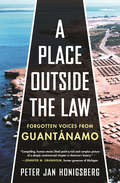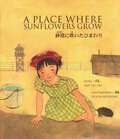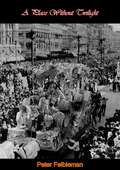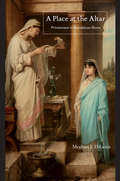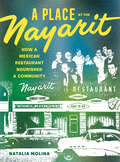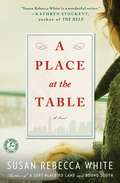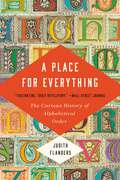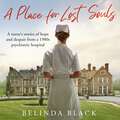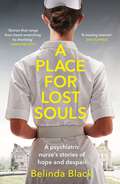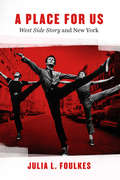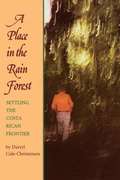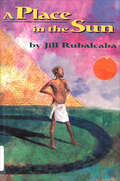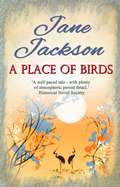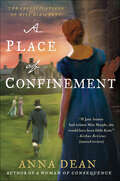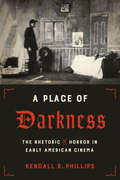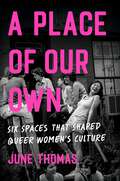- Table View
- List View
A Place Outside the Law: Forgotten Voices from Guantanamo
by Peter Jan HonigsbergFirsthand testimonies from Guantánamo Bay, inspiring future generations to never repeat the human rights violations of the detention center.Law scholar and Witness to Guantánamo founder Peter Jan Honigsberg uncovers a haunting portrait of life at the military prison and its toll, not only on the detainees and their loved ones but also on its military and civilian personnel and the journalists who reported on it.Honigsberg conducted 158 interviews across 20 countries so that the people who lived and worked there could tell their heartbreaking and inspirational stories. In each one, we face the reality that the healing process cannot begin until we start the conversation about what was done in the name of protecting our country. These are a few of them. Many alleged operatives in Guantánamo were purchased by the United States for ransom from Afghan and Pakistani soldiers. Brandon Neely, a prison guard who processed the first group of suspected operatives to arrive in Cuba, flew to London to embrace the detainees he guarded after leaving the military. Navy whistleblower Matt Diaz covertly released the names of 500 detainees by sending them in a greeting card to a lawyer in New York. Journalist Carol Rosenberg committed the past 17 years of her career to documenting life at Guantánamo. And Damien Corsetti, an interrogator who came to be known as the "King of Torture," received ribbons and awards for the same cruel actions for which he was later prosecuted. In startling, aching prose, A Place Outside the Law shines a light on these unheard voices, and through them, encourages the global community to embrace humanity as our greatest tool to make the world a safer place.
A Place That Matters Yet: John Gubbins's MuseumAfrica in the Postcolonial World
by Sara ByalaA Place That Matters Yet unearths the little-known story of Johannesburg’s MuseumAfrica, a South African history museum that embodies one of the most dynamic and fraught stories of colonialism and postcolonialism, its life spanning the eras before, during, and after apartheid. Sara Byala, in examining this story, sheds new light not only on racism and its institutionalization in South Africa but also on the problems facing any museum that is charged with navigating colonial history from a postcolonial perspective. Drawing on thirty years of personal letters and public writings by museum founder John Gubbins, Byala paints a picture of a uniquely progressive colonist, focusing on his philosophical notion of “three-dimensional thinking,” which aimed to transcend binaries and thus—quite explicitly—racism. Unfortunately, Gubbins died within weeks of the museum’s opening, and his hopes would go unrealized as the museum fell in line with emergent apartheid politics. Following the museum through this transformation and on to its 1994 reconfiguration as a post-apartheid institution, Byala showcases it as a rich—and problematic—archive of both material culture and the ideas that surround that culture, arguing for its continued importance in the establishment of a unified South Africa.
A Place We Knew Well
by Susan Carol MccarthyMcCarthy returns with another enthralling story of a family--their longings, their fears, and their secrets--swept up in the chaos at the height of the Cold War. Late October, 1962. Wes Avery, a one-time Air Force tail-gunner, is living his version of the American Dream as loving husband to Sarah, doting father to seventeen-year-old Charlotte, and owner of a successful Texaco station along central Florida's busiest highway. But after President Kennedy announces that the Soviets have nuclear missiles in Cuba, Army convoys clog the highways and the sky fills with fighter planes. Within days, Wes's carefully constructed life begins to unravel. Sarah, nervous and watchful, spends more and more time in the family's bomb shelter, slipping away into childhood memories and the dreams she once held for the future. Charlotte is wary but caught up in the excitement of high school--her nomination to homecoming court, the upcoming dance, and the thrill of first love. Wes, remembering his wartime experience, tries to keep his family's days as normal as possible, hoping to restore a sense of calm. But as the panic over the Missile Crisis rises, a long-buried secret threatens to push the Averys over the edge. With heartbreaking clarity and compassion, Susan Carol McCarthy captures the shock and innocence, anxiety and fear, in those thirteen historic days, and brings vividly to life one ordinary family trying to hold center while the world around them falls apart.
A Place Where Sunflowers Grow
by Amy Lee-TaiBilingual English/Japanese. A young girl finds things to be joyful about in the Topaz Internment Camp.Mari wonders if anything can bloom at Topaz, where her family is interned along with thousands of other Japanese Americans during World War II. The summer sun is blazingly hot, and Mari's art class has begun. But it's hard to think of anything to draw in a place where nothing beautiful grows. Somehow, glimmers of hope begin to surface under the harsh sun--in the eyes of a kindly art teacher, in the tender words of Mari's parents, and in the smile of a new friend. Inspired by her family's experiences, author Amy Lee-Tai has crafted a story rooted in one of America's most shameful historical episodes--the internment of 120,000 Japanese Americans during World War II. The art schools which offered internees moments of solace and self-expression are a little known part of this history. Amy Lee-Tai's gentle prose and Felicia Hoshino's stunning mixed media images are a testimony to hope and how it can survive alongside even the harshest injustice.
A Place Within: Rediscovering India
by M. G. VassanjiA Globe and Mail Best Book. It would take many lifetimes, it was said to me during my first visit, to see all of India. The desperation must have shown on my face to absorb and digest all I possibly could. This was not something I had articulated or resolved; and yet I recall an anxiety as I travelled the length and breadth of the country, senses raw to every new experience, that even in the distraction of a blink I might miss something profoundly significant.I was not born in India, nor were my parents; that might explain much in my expectation of that visit. Yet how many people go to the homeland of their grandparents with such a heartload of expectation and momentousness; such a desire to find themselves in everything they see? Is it only India that clings thus, to those who've forsaken it; is this why Indians in a foreign land seem always so desperate to seek each other out? What was India to me? The inimitable M.G. Vassanji turns his eye to India, the homeland of his ancestors, in this powerfully moving tale of family and country. Part travelogue, part history, A Place Within is M.G. Vassanji's intelligent and beautifully written journey to explore where he belongs.
A Place Without Twilight
by Peter FeiblemanIn the New Orleans of the ‘30s and ‘40s, things—and people—are supposed to be black and white. Cille and her light-skinned brothers are neither. They are “the color that looks not-quite white next to a white man, and not-quite colored next to a colored man. It was a non-color in a place where you had to be something.” The daughter of a dreamy alcoholic father who introduces Cille to “Mr. Keats and Mr. Shelley” but who exits her life too soon, and a mother who teaches her children not the love of God but the fear of him, young Cille struggles for balance and identity in a world where race and class define people for life, and where her brothers destroy themselves beating against the bars of the cage of a divided culture.“A Place Without Twilight is the best novel of 1958, and Peter Feibleman the most exciting discovery.”—NEW YORK HERALD TRIBUNE“An artistic achievement....An ardent new talent telling in fine, sensuous prose the story of an inbetween Alice in a wonderland of blacks and whites.”—NEW YORK TIMES“Engrossing, brilliant, moving…. A full-fledged, first rate achievement.”—CHICAGO TRIBUNE
A Place at the Altar: Priestesses in Republican Rome
by Meghan J. DiluzioA Place at the Altar illuminates a previously underappreciated dimension of religion in ancient Rome: the role of priestesses in civic cult. Demonstrating that priestesses had a central place in public rituals and institutions, Meghan DiLuzio emphasizes the complex, gender-inclusive nature of Roman priesthood. In ancient Rome, priestly service was a cooperative endeavor, requiring men and women, husbands and wives, and elite Romans and slaves to work together to manage the community's relationship with its gods. Like their male colleagues, priestesses offered sacrifices on behalf of the Roman people, and prayed for the community's well-being. As they carried out their ritual obligations, they were assisted by female cult personnel, many of them slave women. DiLuzio explores the central role of the Vestal Virgins and shows that they occupied just one type of priestly office open to women. Some priestesses, including the flaminica Dialis, the regina sacrorum, and the wives of the curial priests, served as part of priestly couples. Others, such as the priestesses of Ceres and Fortuna Muliebris, were largely autonomous. A Place at the Altar offers a fresh understanding of how the women of ancient Rome played a leading role in public cult.
A Place at the Nayarit: How a Mexican Restaurant Nourished a Community
by Natalia MolinaIn a world that sought to reduce Mexican immigrants to invisible labor, the Nayarit was a place where people could become visible once again, where they could speak out, claim space, and belong. In 1951, Doña Natalia Barraza opened the Nayarit, a Mexican restaurant in Echo Park, Los Angeles. With A Place at the Nayarit, historian Natalia Molina traces the life’s work of her grandmother, remembered by all who knew her as Doña Natalia––a generous, reserved, and extraordinarily capable woman. Doña Natalia immigrated alone from Mexico to L.A., adopted two children, and ran a successful business. She also sponsored, housed, and employed dozens of other immigrants, encouraging them to lay claim to a city long characterized by anti-Latinx racism. Together, the employees and customers of the Nayarit maintained ties to their old homes while providing one another safety and support. The Nayarit was much more than a popular eating spot: it was an urban anchor for a robust community, a gathering space where ethnic Mexican workers and customers connected with their patria chica (their "small country"). That meant connecting with distinctive tastes, with one another, and with the city they now called home. Through deep research and vivid storytelling, Molina follows restaurant workers from the kitchen and the front of the house across borders and through the decades. These people's stories illuminate the many facets of the immigrant experience: immigrants' complex networks of family and community and the small but essential pleasures of daily life, as well as cross-currents of gender and sexuality and pressures of racism and segregation. The Nayarit was a local landmark, popular with both Hollywood stars and restaurant workers from across the city and beloved for its fresh, traditionally prepared Mexican food. But as Molina argues, it was also, and most importantly, a place where ethnic Mexicans and other Latinx L.A. residents could step into the fullness of their lives, nourishing themselves and one another. A Place at the Nayarit is a stirring exploration of how racialized minorities create a sense of belonging. It will resonate with anyone who has felt like an outsider and had a special place where they felt like an insider.
A Place at the Table: A Novel
by Susan Rebecca White<p>From Susan Rebecca White, award-winning author of A Soft Place to Land and Bound South, comes a breathtaking story of three richly nuanced outcasts whose paths converge in a chic Manhattan café as they realize they must give up everything they thought they knew to find a home at last. <p>Alice Stone is famous for the homemade southern cuisine she serves at Café Andres and her groundbreaking cookbook, but her past is a mystery to all who know her. Upon Alice's retirement, Bobby Banks, a young gay man ostracized by his family in Georgia, sets out to revive the aging café with his new brand of southern cooking while he struggles with heartbreak like he's never known. Seeking respite from the breakup of her marriage, wealthy divorcée Amelia Brighton finds solace in the company and food at Café Andres, until a family secret comes to light in the pages of Alice's cookbook and threatens to upend her life. <p>In her most accomplished novel yet, Susan Rebecca White braids together the stories of these three unforgettable characters who must learn that when you embrace the thing that makes you different, you become whole.</p>
A Place for Everything: The Curious History of Alphabetical Order
by Judith FlandersFrom a New York Times-bestselling historian comes the story of how the alphabet ordered our world.A Place for Everything is the first-ever history of alphabetization, from the Library of Alexandria to Wikipedia. The story of alphabetical order has been shaped by some of history's most compelling characters, such as industrious and enthusiastic early adopter Samuel Pepys and dedicated alphabet champion Denis Diderot. But though even George Washington was a proponent, many others stuck to older forms of classification -- Yale listed its students by their family's social status until 1886. And yet, while the order of the alphabet now rules -- libraries, phone books, reference books, even the order of entry for the teams at the Olympic Games -- it has remained curiously invisible.With abundant inquisitiveness and wry humor, historian Judith Flanders traces the triumph of alphabetical order and offers a compendium of Western knowledge, from A to Z.
A Place for Lost Souls: A nurse's stories of hope and despair from a 1980s psychiatric hospital
by Belinda BlackA young psychiatric nurse recalls her eye-opening experiences at one of Britain's secure mental hospitals during the 1980s.'Ultimately, my experiences as a mental health nurse have taught me that we should judge less and open our hearts more.'Belinda Black was just seventeen years old when she began working as a nursing assistant at the large and foreboding 'madhouse', as it was then known to the villagers of her hometown in the north of England. Following in the footsteps of her mother, she went on to spend a decade caring for patients with widely varying mental health problems, all locked up together and out of view of society. They included:Olek - a haunted, diminished and damaged survivor of a Nazi concentration campOrla - whose peaceful demeanour and lovely smile hid a determination to kill herselfAgatha - an extremely violent paranoid schizophrenic with a wonderful sense of humourWarren - who stabbed a person to death after he was let out.But A Place for Lost Souls is also about the other psychiatric nurses there, from those like Sister Kane who suffered from depression and found treating others a welcome distraction, to others like Belinda's friend Sally, who always had a sense of humour however dark the situation.Together, against a backdrop of rattling keys, clanging iron doors, and wards that smelled of disinfectant and stale smoke, these people came together to get through another day. Until the hospital, along with many others, had its doors closed in 1991 - the biggest change to mental healthcare in NHS history.The result is a moving, shocking but ultimately life-affirming account of a unique and noble profession, told from the frontlines. Amongst so much sadness and distress, and despite witnessing some of the darkest corners of human suffering, Belinda finds hope: in the camaraderie of her colleagues, in the patients she cares for, and in her unwavering belief that even people who have committed violent crimes are fundamentally good.(P) 2023 Quercus Editions
A Place for Lost Souls: A nurse's stories of hope and despair from a 1980s psychiatric hospital
by Belinda Black'Ultimately, my experiences as a mental health nurse have taught me that we should judge less and open our hearts more.'Belinda Black was just seventeen years old when she began working as a nursing assistant at the large and foreboding 'madhouse', as it was then known to the villagers of her hometown in the north of England. Following in the footsteps of her mother, she went on to spend a decade caring for patients with widely varying mental health problems, all locked up together and out of view of society. Some had suffered unimaginable trauma, several had violent and volatile tendencies, but amongst this Belinda found moments of joy and even friendship with her patients.Together, against a backdrop of rattling keys, clanging iron doors, and wards that smelled of disinfectant and stale smoke, these people came together to get through another day. Until the hospital, along with many others, had its doors closed in 1991 - the biggest change to mental healthcare in NHS history.The result is a moving, shocking but ultimately life-affirming account of a unique and noble profession, told from the frontlines.
A Place for Us: “West Side Story” and New York
by Julia L. FoulkesFrom its Broadway debut to the Oscar-winning film to countless amateur productions, West Side Story is nothing less than an American touchstone--an updating of Shakespeare vividly realized in a rapidly changing postwar New York. That vision of postwar New York is at the heart of Julia L. Foulkes's A Place for Us. A lifelong fan of the show, Foulkes became interested in its history when she made an unexpected discovery: scenes for the iconic film version were shot on the demolition site destined to become part of the Lincoln Center redevelopment area--a crowning jewel of postwar urban renewal. Foulkes interweaves the story of the creation of the musical and film with the remaking of the Upper West Side and the larger tale of New York's postwar aspirations. Making unprecedented use of director and choreographer Jerome Robbins's revelatory papers, she shows the crucial role played by the political commitments of Robbins and his fellow gay, Jewish collaborators, Leonard Bernstein and Arthur Laurents. Their determination to evoke life in New York as it was actually lived helped give West Side Story its unshakable sense of place even as it put forward a vision of a new, vigorous, determinedly multicultural American city. Beautifully written and full of surprises for even the most dedicated West Side Story fan, A Place for Us is a revelatory new exploration of an American classic.
A Place in History: Albany in the Age of Revolution, 1775-1825 (Excelsior Editions)
by Warren RobertsIn 1998, after completing a book on the French Revolution, Warren Roberts took a bicycle ride into the heart of the city in which he had lived for thirty-five years. Thus began a ten-year journey into the history of Albany, New York. Reading about the city's past, poring over old maps, and returning again and again to the city's historic sites with his camera, Roberts found that the more he delved into Albany's history, the more he uncovered about the city's important role in three larger historical narratives: the American Revolution, the French Revolution, and the construction of the Erie Canal. A Place in History is not only about Albany's role in these historical narratives, but is also about the men and women who were caught up in it, their public lives as well as their private intrigues, dalliances, and foibles. As Roberts shows, the history that unfolded along the Hudson River between 1775 and 1825 saved one revolution, caused another, transformed the city of Albany and the state of New York, and ultimately helped lay the foundations of a global economy.
A Place in the Rain Forest: Settling the Costa Rican Frontier
by Darryl Cole-ChristensenIn the 1950s, Darryl Cole-Christensen and his family were among the first settlers of the Coto Brus, an almost impenetrable, mountainous rain forest region of southeastern Costa Rica. In this evocative book, he captures the elemental struggles and rewards of settling a new frontier--an experience forever closed to most people in Western, urbanized society.<P><P>With the perspective of more than forty years' residence in the Coto Brus, Cole-Christensen ably describes both the settlers' dreams of bringing civilization and progress to the rain forest and the sweeping and irreversible changes they caused throughout the ecosystem as they cut the rain forest down. Writing neither to apologize for nor to defend their actions, he instead illuminates the personal and subjective factors that cause people to risk danger and hardship for the uncertain rewards of settling a frontier.
A Place in the Sun
by Jill Rubalcaba"The details of daily life, customs, and beliefs of the people are wonderfully revealed through the words and deeds of the characters.. . . . A substantial glossary helps to identify and explain unfamiliar terms. A fine story for enjoyment or as curriculum support for units on ancient Egypt." School Library Journal —
A Place in the Sun
by Sean MillsWhat is the relationship between migration and politics in Quebec? How did French Canadians' activities in the global south influence future debates about migration and Quebec society? How did migrants, in turn, shape debates about language, class, nationalism and sexuality? A Place in the Sun explores these questions through overlapping histories of Quebec and Haiti. From the 1930s to the 1950s, French-Canadian and Haitian cultural and political elites developed close intellectual bonds and large numbers of French-Canadian missionaries began working in the country. Through these encounters, French-Canadian intellectual and religious figures developed an image of Haiti that would circulate widely throughout Quebec and have ongoing cultural ramifications. After first exploring French-Canadian views of Haiti, Sean Mills reverses the perspective by looking at the many ways that Haitian migrants intervened in and shaped Quebec society. As the most significant group seen to integrate into francophone Quebec, Haitian migrants introduced new perspectives into a changing public sphere during decades of political turbulence. By turning his attention to the ideas and activities of Haitian taxi drivers, exiled priests, aspiring authors, dissident intellectuals, and feminist activists, Mills reconsiders the historical actors of Quebec intellectual and political life, and challenges the traditional tendency to view migrants as peripheral to Quebec history. Ranging from political economy to discussions about sexuality, A Place in the Sun demonstrates the ways in which Haitian migrants opened new debates, exposed new tensions, and forever altered Quebec society.
A Place in the Sun: Haiti, Haitians, and the Remaking of Quebec (Studies on the History of Quebec/Études d'histoire du Québec #31)
by Sean MillsWhat is the relationship between migration and politics in Quebec? How did French Canadians’ activities in the global south influence future debates about migration and Quebec society? How did migrants, in turn, shape debates about language, class, nationalism and sexuality? A Place in the Sun explores these questions through overlapping histories of Quebec and Haiti. From the 1930s to the 1950s, French-Canadian and Haitian cultural and political elites developed close intellectual bonds and large numbers of French-Canadian missionaries began working in the country. Through these encounters, French-Canadian intellectual and religious figures developed an image of Haiti that would circulate widely throughout Quebec and have ongoing cultural ramifications. After first exploring French-Canadian views of Haiti, Sean Mills reverses the perspective by looking at the many ways that Haitian migrants intervened in and shaped Quebec society. As the most significant group seen to integrate into francophone Quebec, Haitian migrants introduced new perspectives into a changing public sphere during decades of political turbulence. By turning his attention to the ideas and activities of Haitian taxi drivers, exiled priests, aspiring authors, dissident intellectuals, and feminist activists, Mills reconsiders the historical actors of Quebec intellectual and political life, and challenges the traditional tendency to view migrants as peripheral to Quebec history. Ranging from political economy to discussions about sexuality, A Place in the Sun demonstrates the ways in which Haitian migrants opened new debates, exposed new tensions, and forever altered Quebec society.
A Place of Belonging: Five Founding Women of Fairbanks, Alaska
by Phyllis Demuth MoviusAlaska has always attracted people from varied backgrounds. In A Place of Belonging, Phyllis Movius introduces us to five women who settled in Fairbanks between 1903 and 1923 and who typify the disparate population that has long enriched Alaska. The women’s daily lives and personal stories are woven together in these biographical portraits, drawn from the women’s letters, memoirs, personal papers, club records, their own oral histories and published writings. Enriched by many never-before-published historical photos, Movius’s research gives us a unique inroad into life on the frontier.
A Place of Birds
by Jane JacksonPA's agency offers Perfect Alibis for the unfaithful. Stephanie - bored housewife and disillusioned mother - wants a job, and Madeleine's recruitment company appears to be the ideal place to go. Except that PAs isn't quite what it seems. Far from providing companies with Personal Assistants, the agency offetrs Perfect Alibis to unfaithful women. And as Stephanie soon discovers, there are lots of them about! Founder member Patsy is a serial philanderer and there's a dark side to her best friend Millie. For the well-heeled ladies of Edenhurst, PA's is a ticket to risk-free adultery. So when Stephanie's first love, Troy returns to town even she is tempted. But her life is soon in turmoil, and that's before the tabloids get involved....
A Place of Confinement: The Investigations Of Miss Dido Kent (Dido Kent Investigations #4)
by Anna Dean“The fourth in this excellent series, beautifully written in the style of Jane Austen, will leave even die-hard mystery mavens puzzled.” —Kirkus ReviewThe dependably sharp Miss Dido Kent has successfully evaded her sister-in-law’s ploy to marry her off. Now, as punishment, she must accompany her wealthy Aunt Manners on a trip to Charcombe Manor. The family hopes that revisiting her childhood home will keep Aunt Manners in good spirits, and Dido in her good graces. But it soon becomes clear to Dido that there is much more at stake.The rich heiress Letitia Verney has disappeared while visiting Charcombe, and Mr. Tom Lomax is suspected of abducting her. Dido is inclined to believe in his innocence, but how is she to explain by what method a young lady could enter through the front door and not appear on the other side? And this isn’t the only enigma that the Elizabethan manor holds: there is a deserted wing in which lights mysteriously appear at night, a crying ghost which keeps visitors awake, and memories of old family quarrels.When the senior Mr. Lomax arrives to defend his son, the mystery intensifies—and so does Dido’s romantic life. With lives and reputations on the line, it’s up to Dido to put the pieces together to save the Lomaxes and find the vanished young Miss Verney.
A Place of Darkness: The Rhetoric of Horror in Early American Cinema
by Kendall R. Phillips&“An illuminating history . . . it&’s clear that the right story can still terrify us; A Place of Darkness is a primer on how the movies learned to do it.&” —NPR Horror is one of the most enduringly popular genres in cinema. The term &“horror film&” was coined in 1931 between the premiere of Dracula and the release of Frankenstein, but monsters, ghosts, demons, and supernatural and horrific themes have been popular with American audiences since the emergence of novelty cinematographic attractions in the late 1890s. A Place of Darkness illuminates the prehistory of the horror genre by tracing the way horrific elements and stories were portrayed in films prior to the introduction of the term &“horror film.&” Using a rhetorical approach that examines not only early films but also the promotional materials for them and critical responses to them, Kendall R. Phillips argues that the portrayal of horrific elements was enmeshed in broader social tensions around the emergence of American identity and, in turn, American cinema. He shows how early cinema linked monsters, ghosts, witches, and magicians with Old World superstitions and beliefs, in contrast to an American way of thinking that was pragmatic, reasonable, scientific, and progressive. Throughout the teens and twenties, Phillips finds, supernatural elements were almost always explained away as some hysterical mistake, humorous prank, or nefarious plot. The Great Depression of the 1930s, however, constituted a substantial upheaval in the system of American certainty and opened a space for the reemergence of Old-World gothic within American popular discourse in the form of the horror genre, which has terrified and thrilled fans ever since. &“[A] fascinating read.&” —Sublime Horror
A Place of Darkness: The Rhetoric of Horror in Early American Cinema
by Kendall R. Phillips&“An illuminating history . . . it&’s clear that the right story can still terrify us; A Place of Darkness is a primer on how the movies learned to do it.&” —NPR Horror is one of the most enduringly popular genres in cinema. The term &“horror film&” was coined in 1931 between the premiere of Dracula and the release of Frankenstein, but monsters, ghosts, demons, and supernatural and horrific themes have been popular with American audiences since the emergence of novelty cinematographic attractions in the late 1890s. A Place of Darkness illuminates the prehistory of the horror genre by tracing the way horrific elements and stories were portrayed in films prior to the introduction of the term &“horror film.&” Using a rhetorical approach that examines not only early films but also the promotional materials for them and critical responses to them, Kendall R. Phillips argues that the portrayal of horrific elements was enmeshed in broader social tensions around the emergence of American identity and, in turn, American cinema. He shows how early cinema linked monsters, ghosts, witches, and magicians with Old World superstitions and beliefs, in contrast to an American way of thinking that was pragmatic, reasonable, scientific, and progressive. Throughout the teens and twenties, Phillips finds, supernatural elements were almost always explained away as some hysterical mistake, humorous prank, or nefarious plot. The Great Depression of the 1930s, however, constituted a substantial upheaval in the system of American certainty and opened a space for the reemergence of Old-World gothic within American popular discourse in the form of the horror genre, which has terrified and thrilled fans ever since. &“[A] fascinating read.&” —Sublime Horror
A Place of Greater Safety
by Hilary MantelBrilliant, edgy historical fiction that catches the jittery, violent flux of the French Revolution." Michael Upchurch, Chicago Tribune Paris, 1789: there are breadlines everywhere, armed beggars on the streets, minor riots most days. On the Left Bank, an obscure but ambitious young lawyer is clawing out a living. Georges-Jacques Danton is energetic, pragmatic, debt-riddenand hugely but erotically ugly. He intends to make his mark, and he doesn't mind how. Maximilien Robespierre is also a lawyer. He is slight, meek, diligentand terrified of violence. He wishes only to do good. Robespierre's dearest friend is a young man of no fixed address. A charming gadfly, erratic and untrustworthy, bisexual and beautiful, Camille Desmoulins is obsessed by one woman and engaged to marry another, her daughter. An inveterate conspirator and a pamphleteer of genius, he soon finds he has a deft way with a crowd. A Place of Greater Safety tells the story of the Revolution through the lives of three men who formed their friendships in youth under the ancien regime, became players during the last days of Louis XVI and his corrupt court, led the mob in the first exhilarating moments of the upheaval, and died, none older than thirty-six, by the hand of the very forces they had brought into being. It is a stunning work of the imagination, one that reveals truths even the best historical accounts cannot match.
A Place of Our Own: Six Spaces That Shaped Queer Women's Culture
by June ThomasA &“riveting&” and &“indispensable&” (Alison Bechdel) cultural history of queer women&’s lives in the second half of the twentieth century, told through six iconic spaces For as long as queer women have existed, they&’ve created gathering grounds where they can be themselves. From the intimate darkness of the lesbian bar to the sweaty camaraderie of the softball field, these spaces aren&’t a luxury—they&’re a necessity for queer women defining their identities. In A Place of Our Own, journalist June Thomas invites readers into six iconic lesbian spaces over the course of the last sixty years, including the rural commune, the sex toy boutique, the vacation spot, and the feminist bookstore. Thomas blends her own experiences with archival research and rare interviews with pioneering figures like Elaine Romagnoli, Susie Bright, and Jacqueline Woodson. She richly illustrates the lives of the business owners, entrepreneurs, activists, and dreamers who shaped the long struggle for queer liberation. Thomas illuminates what is gained and lost in the shift from the exclusive, tight-knit women&’s spaces of the &’70s toward today&’s more inclusive yet more diffuse LGBTQ+ communities. At once a love letter, a time capsule, and a bridge between generations of queer women, A Place of Our Own brings the history—and timeless present—of the lesbian community to vivid life.
